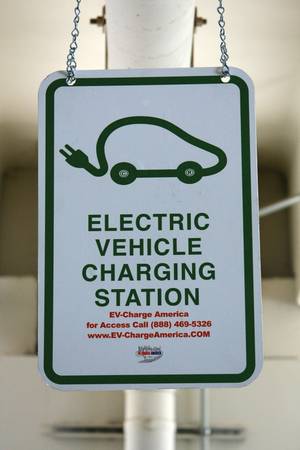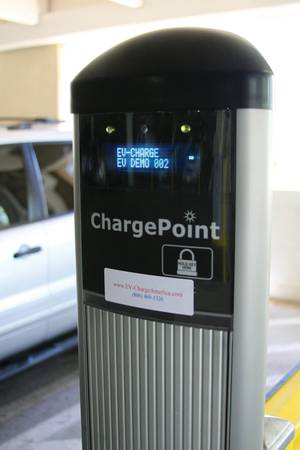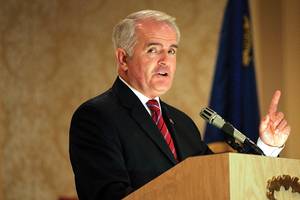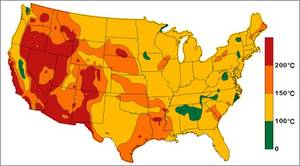As the legislature and Gov. Jim Gibbons argue about to-the-bone budget cuts to try to rescue the state from fiscal ruin, energy concerns have steadily come to the forefront. There are numerous energy-related bills circulating through the Legislature, including one sponsored by Senate Majority Leader Steven Horsford. But the governor has a bill of his own, which, among other things, would raise the state’s renewable portfolio standard to 25 percent by 2025, meaning utilities would have to provide a quarter of their electricity from renewable sources. The bill would also put restrictions on new power plants that emit greenhouse gases.
It’s an aggressive goal, and it’s closely related to another target Gibbons is fond of talking about: to see Nevada become energy-independent by 2020. Currently, utilities in the state spend around $2 billion a year to pay for electricity from out-of-state sources. Energy independence would allow that money to stay in Nevada; the hope is that if we produce more than we consume, we can sell the excess to power-hungry California.
Energy independence is a strange thing to talk about on the state level—when the phrase is used nationally it of course refers to weaning ourselves off of oil that comes from politically tricky places like the Middle East or Venezuela. And energy independence doesn’t mean quite the same thing as increased renewable generation. Only it does, because the state has no meaningful coal or gas reserves. We are, however, awash in geothermal and solar, so any bid toward producing all of our energy in-state is a bid toward ramping up renewables.
What politicians on both sides of the aisle recognize, beyond the PR value, is that Nevada needs more than gaming as a revenue source as it heads into the 21st century. Especially at a time like this, when the state has no money, and its primary industry, tourism, is taking a beating. The days of Vegas, and the state, seeing itself as largely insulated from the rest of the economy are over.
The hope is that the Silver State can become home to a powerhouse green industry. “The renewables have the capability of doing what we did uniquely with mining, followed by gaming,” says Mike Skaggs, executive director of the Nevada Commission on Economic Development. “It became a unique economy for Nevada.”
When Nevada Energy postponed (and perhaps killed) a proposed coal-fired plant in Ely earlier this year, it signaled to many that Nevada is serious about expanding renewable resources. “Energy independence in 2020 is not impossible,” says David Hassenzahl, chair of the environmental studies department at UNLV. “It’s not easy, either. There are a number of things that we would have to do. It really means committing the state very quickly—2025 is more realistic. Three five-year plans might be more tenable than two five-year plans.”
I asked Hassenzahl whether he thought 100 percent renewable power was possible—behind all the percentage standards that governments and utilities like to talk about, this seems to be the real question. He responded, “People will sit down with a straight face and talk about 95 percent. Fossil fuels and oil is so convenient, that’s why we use so much of it. There are some places where it may still be useful. One hundred percent is not impossible in our lifetime, but 95 seems more plausible.”
Among the most optimistic projects is one offered by Charles Benjamin, who runs the Nevada office of Colorado-based environment nonprofit Western Resource Advocates. He believes that with aggressive efficiency programs and increased geothermal and solar production, the state could be at 50 percent renewable by 2015. But we’d better get moving. According to the federal Energy Information Administration, the state used 32 million megawatt hours of electricity in 2006. Just 3.4 million of that came from renewable sources.
Nevada’s richest renewable resources are geothermal and solar power. Geothermal, its proponents are quick to point out, is baseload power, meaning it’s always on. 24/7. The largest player in the field, Reno-based Ormat Technologies, produces about 130 megawatts of electricity a year; other companies supply another 170 or so megawatts. Combined, this is only one-tenth the state’s total geothermal potential, which is around 3,000 megawatts. (This computes to roughly 2.5 million megawatt hours a year.)
Ormat could bring on as many as 100 new megawatts of power per year—other companies could conceivably match that amount in the same time period. “We have more young geothermal companies in Nevada than in the U.S.,” says Paul Thomsen, Ormat’s director for policy and business development. “If they are all successful, I think theoretically [energy independence] could happen.” He thinks the state can accomplish “amazing things.”
But there’s just one small catch: transmission. While Nick Vander Poel, deputy director of the Nevada State Office of Energy, notes that in Northern Nevada “we’re pretty much energy-independent,” the state lacks the transmission lines to get that energy to Southern Nevada. “It’s Southern Nevada trying to catch up,” he says.
The state, through the Renewable Energy Transmission Access Advisory Committee, has identified some $4.5 billion in transmission-line needs, including, says Vander Poel, two north-south lines to link Clark County to the renewable resources in the north.
The state is working with the IRS to craft new regulations that add more flexibility to issue bonds for transmission lines. Of the federal stimulus package, $103 million is dedicated to renewable projects here, including loans to entice new business to the state, funds to weatherize low-income homes and money for environmental-impact statements for the transmission lines. “What I sense is public officials want to see it happen,” says Benjamin. “They want a new industry to start in Nevada. Nevada is very limited being in a desert. Suddenly being in a desert is pretty good.”
Meanwhile, solar resources are, no surprise, also vast, though tapping them is not as efficient as tapping geothermal, and without improvements in storage systems, nightfall means solar won’t be able to function as a baseload power source. Solar photovoltaics, which convert sunlight directly into electricity (they’re what we think of us when someone says “solar panel”), are still not terribly efficient. Solar thermal technology, which converts sunlight into heat, is more efficient, but if heat from the sun is used to turn water to steam to create electricity, this raises questions about its large-scale adoption in a state with limited water resources.
Nevertheless, the solar portfolio in the state is slowly growing. San Diego-based Sempra built the El Dorado Natural Gas Plant in Boulder City in 2002, which generates 480 megawatts a year. Late last year the company opened an adjacent solar plant that puts out 10 megawatts. The company is proposing a 48-megawatt addition to its solar plant, but it wants to have contracts in place first before it begins construction. “We’ll talk to anyone who’s interested in purchasing this power,” says spokesman Art Larson.
The longer you spend talking about renewable energy, the more you realize there are several “elephants in the room” that could change the tenor of the discussion. Nuclear energy is one of them. Nationally the country could get to energy independence much faster with a beefed-up nuclear portfolio, but we obviously haven’t figured out how or where to store the spent fuel rods. (Ironically, agreeing to Yucca Mountain might have aided the country’s energy independence aims.) Another element is the federal Bureau of Land Management, which owns virtually all the land in our state. The Obama administration and new Interior Secretary Ken Salazar are trying to expedite permitting so that land can be tapped more quickly, but a bureaucracy as big as the federal government, with its complex environmental regulatory standards, can only move so fast. And that optimistic 100 new megawatts of power Ormat’s Thomsen talks about depends on faster permitting.
And then there’s California. California, of course, uses significantly more energy than we do, and the state’s proximity could be a blessing or a curse.
On the one hand, California’s renewable-energy portfolio standard is set to rise to 33 percent by 2015, an extremely ambitious goal. Vander Poel believes it’s a goal the state “won’t even come close to and will be forced to import renewable energy from surrounding states to meet their RPS.”
This is good, because it gives us a market to sell to. It’s bad for the same reason. Renewable energy that could be generated in Nevada and used in Nevada may be transmitted to California because California can afford to pay more. Ormat’s geothermal energy is sold to Nevada Energy. But that solar plant in Boulder City, for instance? All of its 10 megawatts go to Pacific Gas and Electric in Northern California. And new geothermal wells in Utah are actually transmitting electricity through Clark County en route to Orange County, California.
On the other hand, an upside to California being so close is that, says Benjamin, “from the labor perspective they don’t care where the power goes, they want the jobs …” But what about those jobs? Any industry needs a permanent and growing workforce. Building a solar plant may take 200-300 workers over 18 months, Skaggs says, “but once you get the field up and running, it’s a maintenance job” that requires, at most, a handful of people.
The trickier challenge is to lure solar-panel component manufacturers to the state. If such an ecosystem could be established, the agglomeration of companies could push Nevada to the forefront of solar production. Of course, to help get there, Skaggs and others talk about the need for greater investment in research and development. To do that, you need a research university spinning R&D into tech startups funded by a healthy stream of venture capital. Silicon Valley has Stanford and Berkeley. (“They’re probably as good at technology commercialization as any universities,” says Skaggs.) The high-tech Route 128 Corridor in Massachusetts has Harvard and MIT. The Research Triangle in North Carolina has UNC and Duke.
We have UNLV. This was a good start when the economy was booming—anybody remember UNLV’s dream of rivaling UCLA?—but now, in the face of enormous budgetary pressures, it seems just a trifle … unimpressive. Our lack of an educational powerhouse is tied to a deeper challenge. Launce Rake of Progressive Leadership Alliance of Nevada—no fans of Gov. Gibbons—notes that states such as Arizona, New Mexico and California have many of the same renewable resources we do. He says tech businesses he’s talked to are turned off by the fact that “our schools don’t work, our health-care system doesn’t work, our social safety system is in tatters, and it doesn’t look like it’s going to get better. That’s it.”
Daniel Burns, Gibbons’ press secretary, responds: “[I think] that’s a shortsighted viewpoint, and the governor believes the same thing. We are farther ahead in our planning to assist these companies. … That outweighs a lot of things. PLAN’s suggestion that we don’t have enough educated people—colleges are still graduating the same number of people.”
Still, while those graduates are presumably good, capable people, it’s uncertain how many of them will choose to stay in Nevada, and regardless, UNLV will be hard-pressed to attract top-drawer talent—the kind of talent that could go to the Stanfords of the world—as long as the state, and the community, doesn’t have the will or the means to foster a superior academic environment.
And vested interests may rear their heads in surprising ways. Benjamin gives the following example: If a strip-mall owner puts up solar panels on his roof, then sells the electricity to his tenants, does that make the strip-mall owner a utility? And will a utility such as Nevada Energy welcome the proliferation of hundreds of small micro utilities, or will it try to shut them down?
UNLV’s Hassenzahl points out that we can’t simply talk about generating electricity from renewable resources. There’s still the automobile and its attendant environmental problems. “How do we move people around without cars, or how do we build buildings so less people need cars? Making that transition in 11 years is a huge problem.” Careful, coordinated urban planning tends to be anathema to the ears of most liberty-loving Americans—especially Nevadans—who see planning as a top-down, gray, vaguely communist enterprise. But Hassenzahl says that with our expansive growth and wide, car-loving arterial roads, “We’ve done a lot of social engineering in the way we’ve built this valley. This is just a change in the way we do social engineering.”
At the least, he says, photovoltaic usage may need to shift from both the model of a centralized power plant and the decentralized, panel-for-every-home approach, and toward a middle ground. He says we should ask ourselves, “Where is it we want shade in this valley,” and then put photovoltaics there. Parking lots, for one. Bike paths, for another—the latter might not only encourage more people to ride their bikes, but if the trails offered some protection from the sun, they might also themselves be useful energy generators.
Hassenzahl recognizes that you can’t change people’s attitudes overnight—but nevertheless, people’s attitudes do change. With one caveat. “If you’re trying to switch to renewable energies … it’s not going to work well politically if it’s couched in any way as decreasing people’s standard of living.”
We tend to think of our standard of living here being more threatened by that other critical resource in the region, water, but we rarely consider the connection between the two. Generating power requires water, and vice versa. “The more we conserve of either or both, the more we save of both,” says Steve Rypka.
Rypka certainly appreciates the interconnectedness of the energy challenge we face. The co-founder of the Nevada chapter of the Green Buildings Council installed solar panels in his home in 2005 for $15,000, taking advantage of a state rebate. “Building them one at a time like that is tough,” he acknowledges. “Imagine if we had the legislation and infrastructure where it just became part of building a home.” In other words, solar panels should be like air conditioners—when you buy a house they’re simply part of the cost of the house.
Rypka is waiting for electric plug-ins, so he can power his car directly off his solar system. The thought of it clearly has him excited. “Every investment I’ve made has turned out to be a good investment.”
Meanwhile, a company called EV-Charge America is rolling out electric charging stations in the West. The majority are planned for—where else?—California. A half-dozen or so are in Las Vegas, with hundreds more planned throughout the state starting at the end of the year. The company’s CEO, Bob Rosinski, says a number of major casinos are embracing the concept, including the Rampart Casino, which has already installed a charging station in its parking garage. Rosinski says there are only 100 electric vehicles in Southern Nevada. Eventually those numbers will grow. “Most of those people are still charging at home,” he says. “They’re not seeking charging stations in the world yet.”
In the southwest end of the Valley, there are vestiges of both the raw, pre-Vegas desert and a more piecemeal model of development, where individuals bought a chunk of land and built their house on it, as opposed to buying a parcel in a huge housing development assembled by a giant homebuilder. It always makes for a fascinating drive, because you can see, in broad, generalized strokes, the trend of development in the Valley over a generation.
There are moments when one can imagine a few tantalizing options—the prospect of even denser, progressively designed communities that could outclass our current neighborhoods in convenience, conservation and aesthetics; or, let’s say (unlikely as it sounds), limited or no development, and instead the preservation of empty parcels of land as small desert preserves. But what’s more likely is that when the economy recovers, and as long as gas is under $3 or $4 a gallon, the same collection of unimaginative developers will build the same communities, and we will continue buying them. Maybe more Energy Star appliances and better gas mileage will cover our collective ass. Maybe not.
Either way, things appear to be moving forward. This week the state is submitting its application to tap the feds’ stimulus money, although no one knows when the first of these critical transmission lines will even break ground.
Meanwhile, Benjamin is confident some of the energy legislation will get through. In an e-mail, he wrote, “Something will get passed that will be an amalgam of a number of bills and ideas working their way through the process.”












Previous Discussion: